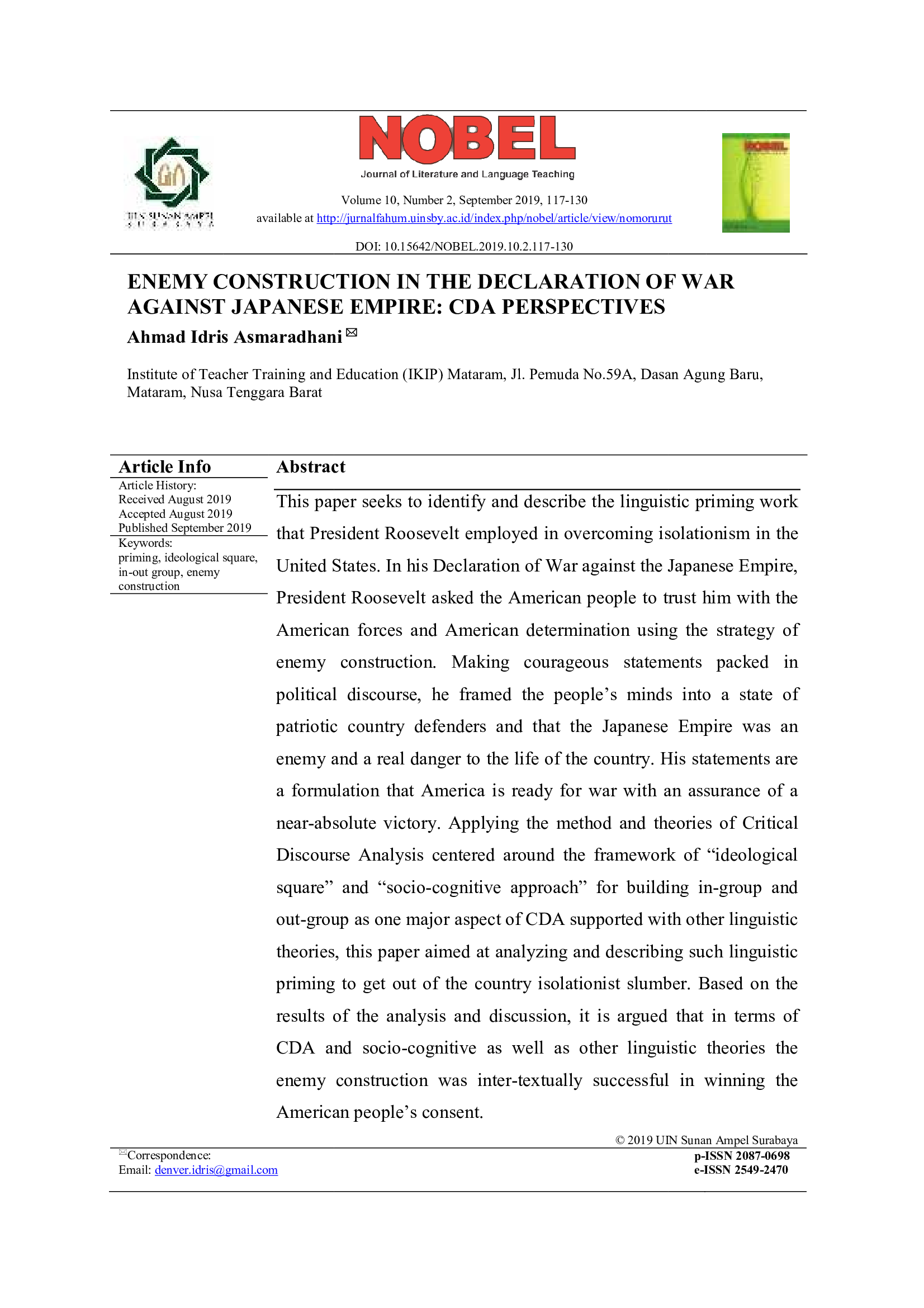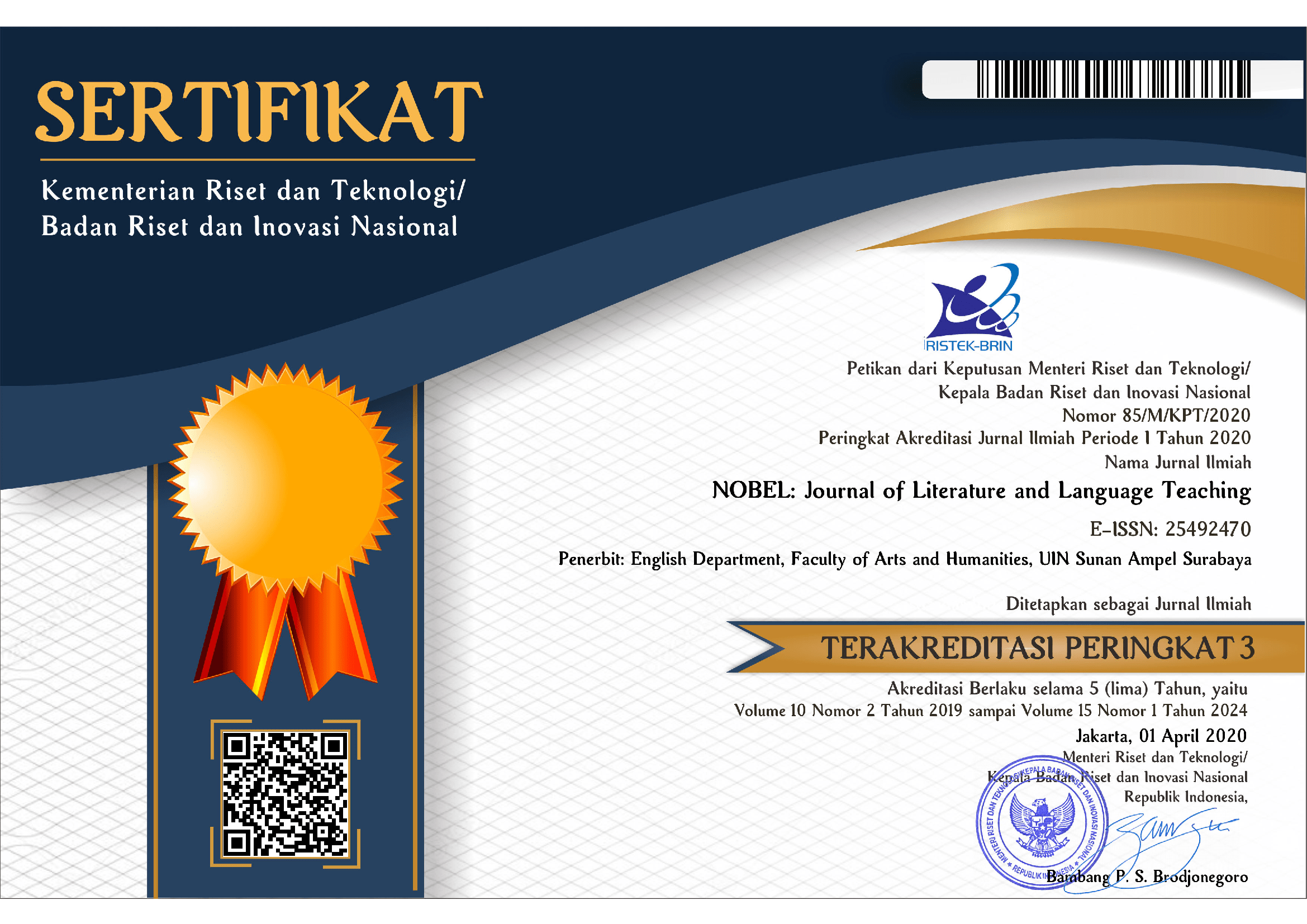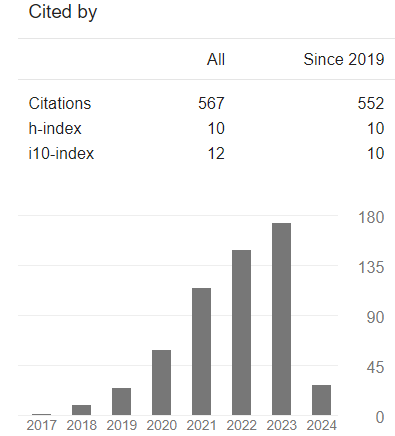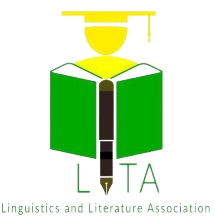Enemy Construction in the Declaration of War against Japanese Empire
CDA Perspective
DOI:
https://doi.org/10.15642/NOBEL.2019.10.2.117-130Keywords:
Priming, ideological square, in-out group, enemy constructionAbstract
This paper seeks to identify and describe the linguistic priming work that President Roosevelt employed in overcoming isolationism in the United States. In his Declaration of War against the Japanese Empire, President Roosevelt asked the American people to trust him with the American forces and American determination using the strategy of enemy construction. Making courageous statements packed in political discourse, he framed the people's minds into a state of patriotic country defenders and that the Japanese Empire was an enemy and a real danger to the life of the country. His statements are a formulation that America is ready for war with an assurance of a near-absolute victory. Applying the method and theories of Critical Discourse Analysis centered around the framework of "ideological square" and "socio-cognitive approach" for building in-group and out-group as one major aspect of CDA supported with other linguistic theories, this paper aimed at analyzing and describing such linguistic priming to get out of the country isolationist slumber. Based on the results of the analysis and discussion, it is argued that in terms of CDA and socio-cognitive as well as other linguistic theories the enemy construction was inter-textually successful in winning the American people's consent.
Downloads
References
Bhatia, A. (2007). “Religious Metaphor in the Discourse of Illusion: George W. Bush and Osama bin Ladenâ€. World Englishes. Vol. 26, No. 4, pp. 507–524.
Bates, B. R. (2004). “Audiences, Metaphors, and the Persian Gulf Warâ€. Communication Studies. 55, 447-463.
Baum, M.A. & Kernell, S. (2001). “Economic Class and Popular Support for Franklin Roosevelt in War and Peaceâ€. Public Opinion Quarterly Volume 65:198–229. 2001. By: The American Association for Public Opinion Research.
Bostdorff, D.M. & Goldzwig, S.R. (2005). “History, Collective Memory, and the Appropriation of Martin Luther King, Jr.: Reagan’s Rhetorical Legacyâ€. Presidential Studies Quarterly, 35 (4).
Chouliaraki, L. & Fairclough, N. (1999). Rethinking Critical Discourse Analysis. Edinburgh: Edinburgh University Press.
Eidenmuller, M.E. (2019). “American Rhetoric: Top 100 Speeches of the 20th Centuryâ€. Retrieved from: https://www.americanrhetoric.com/newtop100speeches.htm
Fairclough, N. (1995). Critical Discourse Analysis: The Critical Study of Language. London: Longman Group Limited.
Fairclough, I. & Fairclough, N. (2012). Political Discourse Analysis: A Method for Advanced Students. USA: Routledge.
Freidel, F. (2019). “Encyclopedia Britanica, Inc.: Franklin D. Roosevelt, President of United Statesâ€. Retrieved from: https://www.britannica.com/biography/Franklin-D-Roosevelt
Grovier, K. (2017). “Eight Words that Changed the Way We Thinkâ€. UK: BBC. Retrieved from: http://www.bbc.com/culture/story/20170303-eight-words-that-changed-the-way-we-think Hinds, L. B. & Windt, T. (1991). “The Cold War as Rhetoric: The Beginningsâ€. 1945-1950. The University of Michigan: Praeger.
Hurford J.R; Heasley, B.; Smith, M.B. (2007). Semantics: A Coursebook. UK: Cambridge University Press
Lange, G. (2004). “United States Declares war on Japan on December 8, 1941â€. Posted on 1/11/2004. HistoryLink.org Essay 5635. Retrieved from: http://historylink.org/File/5635
Moser, J. (2013). “FDR Speaks to a Nation in Crisis, March 4, 1933â€. Ohio: Ashbrook Center at Ashland University. Retrieved from: http://teachingamericanhistory.org/newsletter/201303-2/
Pace-Sigge, M.T.L. (2013). “The concept of Lexical Priming in the Context of Language Useâ€. ICAME (International Computer Archive of Modern and Medieval English) Journal No. 37. Pages: 149-173.
Powaski, R. E. (2017). American Presidential Statecraft: From Isolationism to Internationalism. USA: Springer Nature.
Robert L.B. & Brian, J. (2003). Roosevelt and the Holocoust: How FDR Saved the Jews and Brought Hope to a Nation. New York: Skyhorse Publishing.
Spanos, W. V. (2008). American Exceptionalism in the Age of Globalization: the Specter of Vietnam. New York: State University of New York Press.
Stuckey, M.E. (2018). “Franklin Delano Rooseveltâ€. New York: Franklin D. Roosevelt Presidential Library and Museum. Retrieved from: http://www.fdrlibrary.marist.edu/archives/collections/fdrspeeches.html
van Dijk, T.A. & Kintsch, W. (1983). Strategies of Discourse Comprehension. New York: Academic Press.
van Dijk, T.A. (1984). Prejudice in Discourse: An Analysis of Ethnic Prejudice in Cognition and Conversation. Amsterdam: John Benjamins Publishing.
van Dijk, T.A. (1987). Episodic Models in Discourse Processing. In: R. Horowitz & S.J. Samuels, (Eds.), Comprehensing oral and written language, (pp.161-196). New York: Academic Press.
van Dijk, T.A. (1995). Discourse Analysis as Ideology Analysis. Language and Peace. 10, 47-142.
van Dijk, T.A. (1998). Ideology: A Multidisciplinary Approach. London: SAGE Publications.
van Dijk, T.A. (2000). Ideology and Discourse: A multidisciplinary Introduction. Barcelona: Pompeu Fabra University.
van Dijk, T.A. (2003). 18 Critical Discourse Analysis. (In D. Tannen, D. Schiffrin & H. Hamilton [Eds.]), Handbook of discourse analysis. (pp. 352-371). Oxford: Blackwell.
van Dijk, T.A. (2009). “Critical Discourse Studies: A Sociocognitive Approach†(in Wodak and Meyer [Eds.] Methods of Critical Discourse Analysis (pp. 62-85). London: SAGE.
Weber, J.L. (Ed.). (2010). Key Concepts in American History: Isolationism. New York: Chelsea House Publishing.
Wills, C. (2006). Decades of American History: America in the 1940s. New York: Stonesong Press, LLC.
Wodak, Ruth and Michael Meyer (Eds.). (2001). Methods of Critical Discourse Analysis. London: SAGE Publications Ltd.







